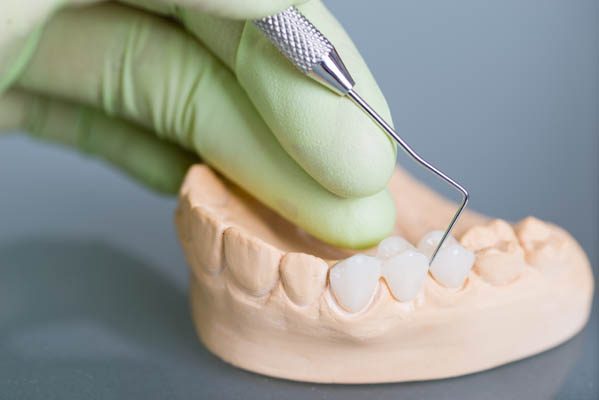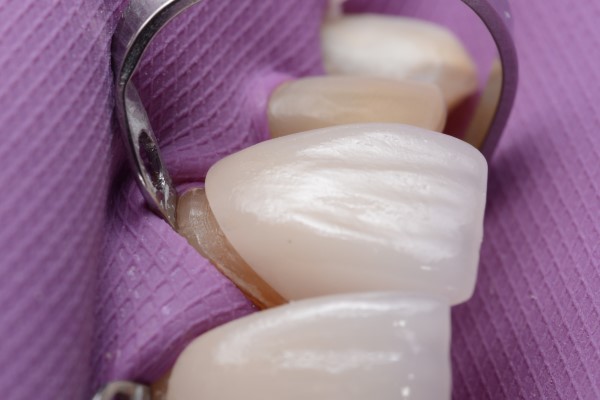What Are Dental Bridges?

Dental bridges are made up of artificial teeth that close spaces between teeth and dental crowns that are placed on the teeth closest to the gap. These oral prosthetics are typically used to close up gaps in a person’s smile due to missing teeth.
Dental bridges are a less-invasive approach to replacing missing teeth than implants. However, getting a bridge is more invasive than dentures because the teeth that will be used to anchor down the artificial teeth have to be prepared for dental crowns by removing enamel from their sides. The artificial teeth that come with a dental bridge are called pontics, while the teeth used to anchor down the restoration are called abutments.
Everything that you should know about bridges and dental crowns
Dental bridges are cheaper options to replace missing teeth than implants, but they cost more than dentures. Bridges are typically fixed in place once installed by a dentist.
The procedure typically involves making at least two trips to the dentist. The first visit is used to evaluate the patient to see if a dental bridge is the right solution for them. Here is what goes on once a patient has been cleared for a dental bridge:
The dentist starts the process by preparing the patient’s teeth for dental crowns. The patient is injected with a local anesthetic to numb the abutments so enamel can be removed from their sides. Removing enamel from the teeth being fitted with the crowns leads to a better fit.
An impression of the patient’s mouth is taken by having them bite down on a mold. The mold is sent to technicians who make restorations like dental bridges in a lab. The finished product is sent back to the dentist within two weeks. The prepared teeth are covered with a temporary bridge to protect them in the meantime.
The patient is called back for a second appointment when their custom bridge returns to the dentist. The temporary crowns are removed, and the crowns attached to the pontics are placed on them. Alterations are made as needed to complete the treatment.
Benefits of replacing missing teeth with a dental bridge
- It restores the appearance of the patient’s smile
- It helps maintain the patient’s facial structures
- It restores the patient’s ability to speak and chew
- It evenly distributes bite forces on all the patient’s teeth
- It prevents the remaining teeth from moving out of their proper alignment as they try to close up the space left by the missing teeth
Some patients might undergo an adjustment period when a dental bridge is placed in their mouth. Most people get used to having the restoration in their mouth within a few days.
Dental bridge FAQs
These are some of the most common questions that people ask about bridges.
How long do bridges last?
When properly taken care of, bridges can last 10-15 years or even longer. To ensure that your bridges last as long as possible, it is important to brush and floss daily as well as to visit your dentist regularly. Most patients who have bridges visit their dentist once every six months for cleanings and check-ups.
Can I take my bridges out during the day?
No, you cannot remove your bridges throughout the day or overnight. They are fixed dental prosthetics. This means that they are bonded to your teeth and cannot be taken out. This is actually beneficial because you never need to worry about them slipping out at an inopportune time. However, if you would prefer something that is removable, perhaps it is better to look into dentures instead.
Are there different types of dental bridges?
Yes, there are different types of dental bridges. The most common type is simply known as traditional bridges. Traditional bridges include one or more false teeth and use crowns to support them on either side. You may also hear of Maryland bridges or Cantilever bridges. Maryland bridges fix the pontic only to one side of the natural teeth, typically the ones furthest in the back. These require no filling. Cantilever bridges are usually used when the gap of missing teeth only has healthy teeth on one side of it.
Close the gap in your smile
Everybody deserves to have a smile that they can be proud of, and bridges allow you to have just that. Are you ready to restore your smile? Fall in love with your smile again. Give us a call or stop by our Houston clinic to learn more about how dental bridges are used to replace missing teeth and the benefits of doing so.
Request an appointment here: https://www.houstonpersonaldentist.com or call Jeff Tollett, DDS at (713) 481-3045 for an appointment in our Houston office.
Check out what others are saying about our dental services on Yelp: Dental Bridges in Houston, TX.
Recent Posts
If you are seeking tooth replacement options, a dental bridge can often be the treatment suggested by a dentist. There are many benefits that come with using a dental bridge to replace one or more missing teeth. Replacing a lost tooth covers the gap left by the missing tooth to prevent the remaining teeth from…
A dental crown is a device used to restore the functions and look of a tooth that has been damaged. If you need a root canal, a fractured tooth, or a big filling, your dentist may also decide to place a dental crown. The new crown covers the part of the tooth visible above the…
If you’ve ever broken a tooth, then you’ve likely had a dental crown put on. What you may not know is what exactly a crown is and how they are used by the dentist. The crown itself is a very versatile dental application that works to restore the shape of a tooth as well as…
When there are issues with the teeth, a dentist performs a variety of procedures to treat them, and one is the placement of dental crowns. A crown is a cap that looks like a tooth, and it covers an existing tooth to restore function. A crown protects a tooth and prevents further issues from occurring. A…


